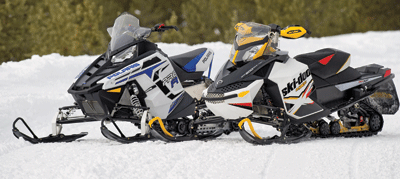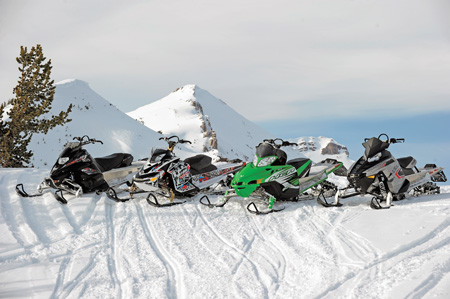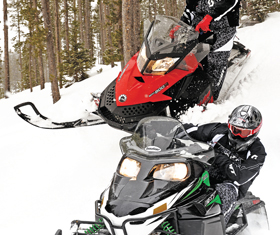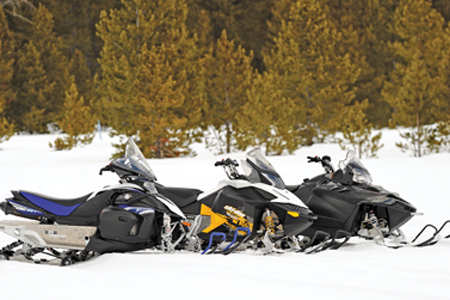 Drivers of 600-class snowmobiles typically ride hard, so we put the machines through their paces to see which performed best when ridden aggressively. We evaluated each machine based on its performance when pushed hard. Some trails were smoother, and we took performance there into account, too.
Drivers of 600-class snowmobiles typically ride hard, so we put the machines through their paces to see which performed best when ridden aggressively. We evaluated each machine based on its performance when pushed hard. Some trails were smoother, and we took performance there into account, too.
Four riders took part in the two-day test: Editor Tim Erickson; Associate Editor Andy Swanson; test rider and past I-500 champ Nolan Knochenmus and former Snow Goer Editor Eric Skogman.
Testing grounds were rough. We rode the trails near Daniels Summit, Utah, and many sections of trail were as rough as a snocross track. Conditions warranted testing an F6 Firecat Sno Pro instead of the standard suspension package, but the company didn’t bring the mogul masher to the test.
We could’ve tested the Ski-Doo MX Z “X” but comparing a standard Firecat to it would have been unfair. Polaris and Yamaha do not offer suspension packages that are more aggressive than what we tested.
We should note that the location of our testing grounds moved just two days prior to our arrival in Daniels Summit, so Arctic Cat, Ski-Doo and Yamaha were faced with altitude and trail conditions that were different than what their machines were initially set up for.
Polaris hosted its dealer intro from the test’s staging area during the week prior to our test. Judging by the 600 HO Fusion’s engine and suspension performance, we assume the sled was dialed in better than the other makes for the trail conditions and altitude.
Potent
Powerplant
The Liberty 600 HO engine is the best motor based on performance in the 600 class. Despite that Polaris had more time to set up its Fusion’s clutches and carburetors for the conditions at 8,200 feet, it’s safe to score a win for Polaris here. Though none of the 600-class engines were as crisp and quick as they are in the flatlands, the 600 HO was torquey and pulled hard.
In addition to rides last spring, we’ve logged a lot of miles with the other factories’ powerplants, which are unchanged for 2006 except for the addition of Cat’s exhaust pipe temperature sensor.
The Liberty 600 HO is a 599cc twin with solenoid-controlled variable exhaust valves and dual Mikuni TM38 carbs. Its layout is traditional with rear intake and forward exhaust ports.
The crankcase is based on Polaris’ 440cc race motor. It has “W” shaped reeds for better flow and longer petal life. The NiCaSil-lined cylinders have a 77.24 mm bore. The crankshaft’s stroke is 64 mm. Polaris rates the engine at 120 hp.
Based on test rides near Daniels Summit, the Liberty 600 is the most responsive of the bunch. Power was always on tap when coming out of corners or burping the throttle to leap off a mogul. The engine revved quickly and its clutch calibrations let it pull hard.
Fuel delivery was spot on. The engine never gurgled and it always started easily in the warm, spring air whether the engine was hot or cold — as long as we slightly opened the thottle while pulling the recoil rope. Acceleration was crisp
and clean.
Rotax’s 600 H.O. SDI ranks No. 2. The 593cc semi-direct injected engine provides the smoothest, most linear power of the 600 two-strokes. Fuel delivery and throttle response is spot on, most of the time.
During test rides, the Rotax engine cut out on occasional hard landings due to lapses in fuel delivery. The cuts in power were minute and never caused the machine or driver to become unsettled; they were a nuisance more than anything else.
Picking a third-place engine for this shootout is a tough call. Performance of the F6’s Suzuki twin and the Nytro’s Genesis 120 were equally less-than-expected. Normally we’d put Cat’s 600 ahead of Yamaha’s Genesis 120 four-stroke, but the laydown Suzuki’s performance suffered the most from the altitude, so it gets fourth place in this shootout.
Yamaha’S Genesis 120 offered ho-hum performance; it wasn’t what we’re used to from the three-cylinder, four-stroke. Like the Firecat, the engine took a while to spool up, but once it did, the sled accelerated quickly.
There weren’t any glitches, stutters or hiccups from the Genesis engine. It started easily and idled smoothly, but its performance didn’t blow us away, either.
Power delivery is different than a two-stroke. Drivers need to modulate fuel delivery from the three 40mm Keihin carburetors differently than a two-stroke, mostly due to its engine braking. Once drivers adjust to the powerplant’s reaction when letting off the throttle, the engine is a piece of cake to drive through twisty trails.
Throttle response from the F6’s 600 EFI II engine was slow on the low end, but once the revs increased, the acceleration picked up. Perhaps clutch calibrations were off. The machine acted as though its driven clutch had a helix with an angle too steep or the spring was too soft, which didn’t let the clutch backshift quickly.
The engine always started easily and idled well, just like Cat’s batteryless EFI always has. We didn’t notice a difference in running quality as a result of the new exhaust pipe temperature sensor.
Ergonomically speaking
Everything about the Nytro’s ergonomic setup is comfortable. For that reason, its ergos earn the highest ranking in this shootout.
Ergonomics are what makes the Nytro a legitimate competitor in the 600 performance class. Tall handlebars with hooked ends, a sculpted gas tank and console and wide foot rests with a lot of traction make it easy for a driver to move and affect the machine’s behavior.
The tall handlebars and an overstuffed seat offer one of the best riding positions available from a stock snowmobile for aggressive riders. Whether standing or sitting, the Nytro is comfortable and transitions are easy to make. The handles are thick and the steering post/handlebars are sturdy.
Ski-Doo’s MX Z has the second best ergonomics of the four sleds. It’s the runner-up because its seat is too soft and too low.
The REV chassis set a new standard for ergonomics when it was introduced in 2003. The rider-forward design put the driver in a better position for control and ability to react to the terrain. Adjusting from a seated to standing position is almost effortless, which translates to a better ride.
Before Ski-Doo made it easy to stand up on a snowmobile, riders stayed planted on their seats and subjected their backs to nasty bumps. But now that it’s easy to rise off the seat and let knees absorb the bumps, snowmobiling is more comfortable. But Ski-Doo can do even better.
The MX Z Adrenaline’s seat is too soft and too low to catapult the machine into the lead for ergonomics. A taller, firmer seat, as used on the “X” package machines, would reduce the bend at the driver’s knees, reduce fatigue in the thighs and make transitions even easier.
Third place in the ergos department goes to the F6. It has perfect handlebars and a nicely arranged cab and fuel tank, but its seat and footrests are stuck in the ZR era.
Cat has had handlebar design and layout nailed for years, and no other sled manufacturer has bested it. Its shape, height, width, rake and hook angles work wonderfully for aggressive and leisured riders who are seated.
Its handlebar grips offer enough traction for a hand to stay put, but they don’t restrict movement when a hand needs to quickly rotate on the bar to set up for a turn.
The fuel tank and smooth seat cover make it easy for a driver to transfer from side to side. For a high-speed curve on a smooth trail, a driver just needs to wedge his outside foot in the footwell, lean into the corner and pull on the handlebars — the sled will rail flat through the turn.
The F6’s seat is too low. Testers felt like their knees could hit their chins. Another 2 inches of stuffing would work wonders for the Firecat.
The Firecat is awkward for stand-up riders; its handlebar height is too low. Riders must lean over the bars rather than stand nearly straight up like they can on the Nytro, MX Z and Fusion. The handlebars can be adjusted to improve the feel, but that will compromise comfort and control when seated.
Polaris gets last place in the ergos category for one glaring fault: its handlebars. All testers agreed that the Fusion was difficult to turn, partly due to its heavy steering, but mostly because of its awkward handlebars. Turning to the left was especially difficult.
We always found ourselves turning with the end of the handlebar jammed in the palm of our left hand. This was not only uncomfortable, it made it difficult to feather the brake.Were the handlebars too high? Too far forward? Too far back? Different settings with the Rider Select Steering System didn’t help.
The handlebars weren’t wide enough, either. We felt cramped. The diameter was too small, too. Polaris should check out Yamaha’s Nytro for guidance on that problem. Before we move on, we’ve got one more gripe: the grips are too grippy. We couldn’t easily roll our hands to prepare for a turn. Check out Arctic Cat for help on that problem.
We liked the Rider Select Steering System for its adaptability to terrain and the driver’s mood, but it didn’t lessen the annoyance of handlebars that finished in fifth place of a shootout with only four sets of handlebars. Yes, they’re that bad.
What did we like about the Fusion’s ergos? Its seat is tall, narrow and firm. This design works well for aggressive riders because it’s easy to stand up or transition from side to side when a person wants to throw his weight off the edge. The cushion was comfortable for subdued rides, too.
The cab and tunnel also work well for active riders. Body movement is uninhibited and there’s plenty of traction, but the chaincase takes up valuable space in the right footwell.
Riders can’t put their right feet straight in the stirrup; toes end up pointed toward the right. People who wear big clodhoppers will have trouble getting their foot in place.
suspension supremacy
The 600 HO Fusion is the sled to beat when tackling rough conditions regardless of speed. The other three sleds didn’t handle a pounding with as much control and stability as the Fusion.
Testing conditions were a mogul masher’s dream. Trails were littered with 2- to 4-foot rollers along with sections of smaller chop thrown in the mix. There was a lot of elevation change, too, that presented many several-foot dropoffs where sleds went airborne.
Trail conditions dictated our criteria for judging suspensions. But because many 600-class riders are aggressive drivers, performance in the rough between 40 and 60 mph was an important factor of our ratings for this test. Had the trails been paper smooth, the finishing order might have been different. We wouldn’t have realized the Fusion’s ability in the rough and the other manufacturers’ weaknesses wouldn’t have been as obvious.
The Fusion’s suspensions stood out in the mined-out sections with big whoops and sharp-edged moguls. On aggressive rides where we pushed the four sleds to their limits, the Polaris was the preferred machine — by far.
Suspension calibrations were such that we could use the travel without any harsh bottoming — it felt firm, not stiff. When the sled flew off a mogul, it flew flat and straight and set itself down gently.
In smooth conditions, the Fusion worked well, but it wasn’t as supple as the MX Z Adrenaline, which was expected considering the Polaris’ leading performance in the rough.
The MX Z Adrenaline earns the silver medal for suspension performance in the rough, but it gets the gold when the trails were smoother.
Suspension calibrations are too squishy for aggressive riders who like to hit the bumps hard. Fortunately, the machine flew flat and straight when it got pitched off of bumps and allowed us to keep the machine under control.
With a 155-pound rider on board, the SC-4 rear suspension bottomed easily in a section of 2- to 3-foot rollers taken at about 40 mph. The torsion springs were in the second softest setting. After a few miles, we pulled over and clicked up the front track shock’s spring preload two positions from the softest setting. We cranked up the IFS preload two clicks, too.
The suspension adjustments tightened up the feel of the sled and helped resist bottoming in big bumps, but it didn’t work as well as the Fusion. Really aggressive riders need the “X” package, which has remote reservoir shocks, stiffer valving, firmer springs and a falling rate swaybar for a tighter feel.
On smoother trails with scattered bumps and ruts, the MX Z Adrenaline’s suspension packages are calibrated appropriately. They absorb smaller, softer bumps and holes without bottoming or kicking back too much.
The F6’s suspensions come in third place. Though the machine handles very well, its suspensions don’t tackle the bumps as well as Polaris and Ski-Doo’s sleds.
In rough conditions, we crashed through the front torque arm’s travel and bottomed out. The machine isn’t stable in rough conditions.
Bumps pitched the nose of the sled in the air without rhyme or reason of which direction the sled would bounce in reaction to a bump. Firecats have always had this trait. Is it due to its narrow, 13.5- by 128-inch track? Cat’s new Crossfire has a 15- by 136-inch track, and it’s much more stable in rough conditions. Like the MX Z Adrenaline, the F6 works well when conditions aren’t so rough.
Yamaha’x Nytro finishes in fourth place in suspension comparisons due to its sub-par rear suspension setup. The Pro Active CK suspension’s dual shock, torsion spring setup is a capable design, but all testers agreed its performance at Daniels Summit was below the other sleds.
We can’t stress enough how rough the trails were, but all machines were subjected to the same conditions. We tried to count how many times the Pro Active CK suspension bottomed in a 1-mile section, but we lost count after a few hundred yards.
The rear suspension isn’t a total loss, though. It transferred weight well and offers adjustability. The skid worked fine on smoother trails and will be adequate for less-aggressive riders.
The front suspension’s performance was polar opposite of the rear’s — we never bottomed out. The Nytro’s A-arm front end is equipped with springless Fox FLOAT shocks, which get progressively stiffer as they compress.
easy-handling
For its easy, predictable handling, the MX Z Adrenaline gets top honors in this category.
The MX Z corners well and instills confidence. The front end carves its line and stays flat while the rear loosens up a bit to help point the nose in the right direction. The changes up front and the new skis get credit for the improvements.
Ski-Doo engineers lowered the front end 1.5 inches, but the chassis only lost .5 inch of suspension travel so riders aren’t likely to notice a difference in ride quality.
Earlier REV-chassis MX Zs have suffered a bit in terms of stability through corners — especially at faster speeds. But the lowered front end and new Pilot skis bolted to the RAS front end keep the boards pointed down the trail with hardly a hint of tippiness.
New Pilot 5.7 skis are a dual-runner design that has a center and outboard keel, which reduces darting but does not compromise handling in loose snow.
Polaris’ 600 HO Fusion is the second-best handling sled in the shootout. The sled suffers some inside ski lift, but not enough to cause concern of tipping.
An updated spindle design with a reduced caster angle was developed for all 2006 IQ-chassis sleds for better traction. In rough conditions, the skis held their line while the suspension sucked up the bumps and kept the machine on course. The only downfall is the machine’s heavy steering characteristics.
The Fusion requires much more effort than the MX Z to sneak through a twisty section of the woods. Less ski pressure would relieve the condition, but would the sled’s handling characteristics suffer?
This is another category where it’s difficult to put a machine in last place. But because this is a test conducted on rough trails and based on each machine’s performance there, the Nytro takes third place ahead of the F6.
Other than a bit of tippiness in corners, the Nytro handled well. Skis held their line and steering effort felt fine through turns. We figure the sled lifted its inside ski because of the stiff setup, but that can be easily remedied.
On test rides, the Fox FLOAT shocks had 80 psi of “spring” preload, Yamaha officials said. Reduced preload settings, valving changes and 1- to 1.5-inch spacers in the shocks would lower the front end and make the sled more stable.
The tradeoff of this modification is less suspension travel. Reduced air pressure will lower the ride height, too, without sacrificing suspension travel, but the sled will be less resistant to bottoming.
Production Nytros are equipped with updated FLOATs that have a small, internal spring to reduce stiction; our test sled did not have the updated shocks. This is meant to let the shock work smoother and should improve handling.
The F6 is the best handling machine on smooth trails, but if the trails are rough, drivers are kept busy holding the Firecat on track.
If trails are smooth, a driver can easily whip through the woods with little risk of the machine coming unglued from the trail. Its low center of gravity and soft shocks and springs help keep the skis and track on the snow. Throw in a few bumps and it becomes a different story.
The Firecat chassis isn’t stable in rough conditions, which negatively affects its handling ability. The skis easily get disconnected from the trail when its suspensions bottom and the machine bounces. The machine’s light figure makes it manageable, though, and drivers can pull the sled back on course.
Squeezing the throttle when coming out of a corner transfers too much weight and pulls the skis off the ground. Changes in spring preload, limiter strap length, shock valving, shock mount location and coupler block adjustments affect weight transfer and are worth experimenting with to dial in a Firecat for better handling in rough conditions.
An F6 Sno Pro has a much stiffer suspension setup that resists bottoming and is a better choice for super-aggressive riders. But keep in mind, it has a very firm setup.
A Tough Decision
Picking the winner in this shootout boiled down to two contenders: Ski-Doo’s MX Z 600 H.O. SDI Adrenaline and Polaris’ 600 HO Fusion.
The 600 HO Fusion is what Polaris should have brought to the table two years ago to debut its IQ chassis. Versions of the new sled we tested past spring ran smooth, were dialed in and flat-out ripped through rough trails.
But the MX Z is a better all-around performer than the Fusion. It’s easier to drive due to better ergonomics and lighter steering. Throw in a time-tested engine and an updated front suspension that greatly improves handling over previous versions and that makes a top-notch middleweight snowmobile.




